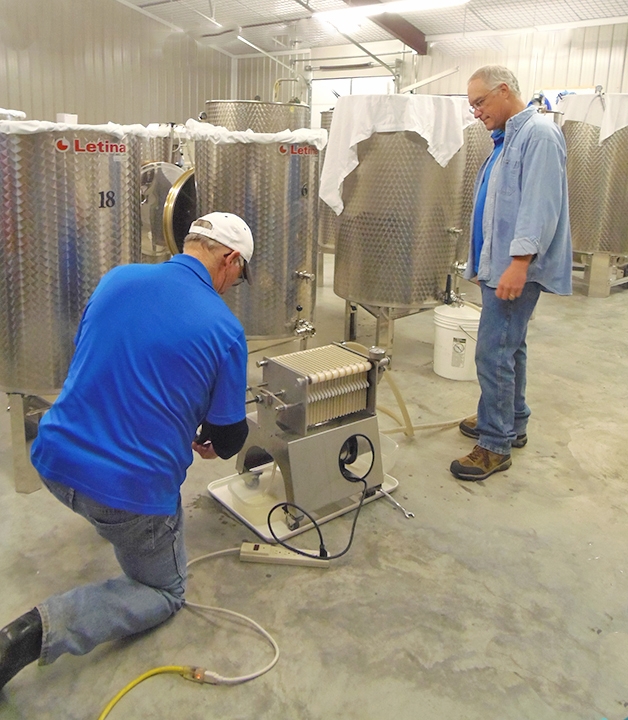Grape Expectations

By Randy Grider
and Lee Ellen Benjamin
Cheers!
Texas is in the top 10 in the United States in both wine production as well as the number of wineries.
Texas’ wine-making industry gained momentum in the late 1960s and has grown steadily ever since.
Texas now boasts more than a dozen wine trails, encompassing more than 200 wineries.
The wines of Texas offer something for every tastes -- from unapologetic wine snobs to novices seeking a glass agreeable to their respective palette.
In this part of the state, the Piney Woods Wine Trail is comprised of wineries of every size and styles. The trail is made up of almost two dozen establishment spread across northeast Texas.
In Cass County, O’Farrell Country Vineyards is the most obviously starting point if you are inclined to make the entire trail a bucket list item.
O’Farrell, owned and operated by Benny and Judy Moore, specializes in muscadine wines produced from multiple varieties of the black and gold muscadines.
The winery tasting room offers visitors a comprehensive line of wines from which to choose and plenty of yesteryear ambiance. Originally, the tasting from was a working barn and attendees can still see remnants of the hayloft, but the hidden surprise is that the wood and foundation are from the O’Farrell School, which stood on the spot where the vineyard exists today. There is also a great deal of rescued wood from the family farm at Bear Creek.
When Judy Moore’s family homestead in Bear Creek was to be torn down, they salvaged as much tin and wood as possible, which is now in the tasting room. The floor boards, the walls and ceiling, doors and the lovely mantle piece are all from the century-old home. The boards were power washed and used to construct the barn.
It was dogrun-style home, which stood for more than 100 years, but the Bear Creek fire in 2011 took the last bits and pieces. The last item rescued was the porch swing. Therefore, not all the walls in the vineyard barn could be completed with the same wood.
The O’Farrell School, a doctor’s office and a Methodist Church were on the north side of Farm-to-Market 995, where the vineyard is today. Across the road was a Woodman of the World co-operative store. Woodman of the World is a fraternal organization dating back to the 1890s, where members could also purchase insurance and annuities.
Some of the décor outside the buildings are items the Moores discovered as they dug to plant vines, which include all sorts of antiques odds and ends. The pews in the outdoor tasting area are from the original Bethlehem Baptist Church, which is now located down the road a way.
There was a clay basketball court by the O’Farrell School and there were still signs of the court when they bought the property in 1981. A prior postmaster, Tom Tate, had owned a home on the site. Portions of the foundation of his home were also evident when they began the vineyard.
The Moores live in a cozy home next to the vineyard, which is two buildings put together: one from Red River Army Deport and another from Indian Hills Country Club. There is a separate kitchen and bathroom in a smaller building and all of the wine-making process happens in the much larger building to the side of the old barn.
From picking to bottling, it takes about three months and it takes many hands to complete the process. The Moores started with four 20-gallon tanks, but now have an assortment of sizes and types of tanks.
The 150-gallon cold stabilization tank causes acid to titrate out of the grape solution. The enormous tank is a multi-layered steel receptacle, which cycles a food-grade glycol and water mixture through the outer skin to chill the grape liquid to 26 degrees. It stays cool for about three weeks. This process removes the bitter acidic taste so the wine becomes smooth.
At the end of this procedure, the tank is drained and cleaned with steam and hot water. However, this is just one of the many methods of fermentation used at O’Farrell Country Vineyards.
Every bottle is hand corked and hand labeled. Once the bottles are corked and labeled, they are placed in cases and stored in a secure, temperature-controlled room.
Because Cass County is a “dry” county, the state requires that 75 percent of all goods used to make wine originate from Texas. Every ingredient has to be logged and be reported to the state government semi-annually.
The vineyard is also a popular stop during “u-pick” harvest season in late summer. Muscadines are known for their sweet goodness that a great for eating right off the vine or used to make jellies and other sweet treats.
Other wineries on the trail and within a short drive of Atlanta include Los Pinos Ranch Vineyards and St. Rose Vineyard & Winery, both near Pittsburg, Red Road Vineyard and Winery in Naples and Enoch’s Stomp Vineyard & Winery just southwest of Jefferson.
For more information on O’Farrell, visit www.ofarrellvineyard.com and for the Piney Woods Wine Trail, visit pineywoodswinetrail.com.
- Log in to post comments







